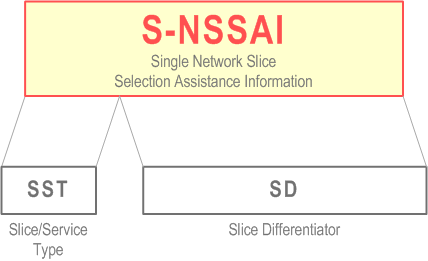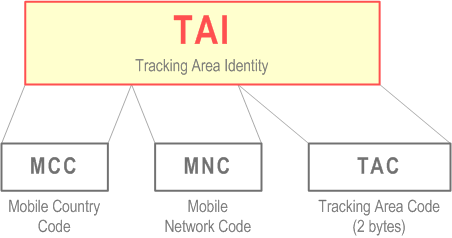Content for TS 23.003 Word version: 19.0.0
1…
2…
2.8…
3…
4…
5…
6…
7…
8…
9…
10…
11
12…
13…
14…
15…
16…
17…
18…
19…
19.4…
19.5…
20…
21…
22…
23…
24…
25…
26…
27…
28…
28.3.2.2…
28.3.2.2.6…
28.3.2.3…
28.4…
28.7…
28.8…
29…
A…
B…
C…
D
E…
28.4 Information for Network Slicing
28.4.1 General
28.4.2 Format of the S-NSSAI
28.4.3 Ranges of S-NSSAIs
28.4.4 Network Slice Instance Identifier (NSI ID)
28.4.5 Network Slice Admission Control (NSAC) Service Area Identifier (SAI)
28.5 NF FQDN Format for Inter PLMN Routing
28.6 5GS Tracking Area Identity (TAI)
...
...
28.4 Information for Network Slicing p. 125
28.4.1 General p. 125
In order to identify a Network Slice end to end, the 5GS uses information called S-NSSAI (Single Network Slice Selection Assistance Information). See clause 5.15.2 of TS 23.501.
An S-NSSAI is comprised of:
- A Slice/Service type (SST),
- A Slice Differentiator (SD), which is optional information that complements the Slice/Service type(s) to differentiate amongst multiple Network Slices.
28.4.2 Format of the S-NSSAI p. 125
The structure of the S-NSSAI is depicted in Figure 28.4.2-1

The S-NSSAI may include both the SST and SD fields (in which case the S-NSSAI length is 32 bits in total), or the S-NSSAI may just include the SST field (in which case the S-NSSAI length is 8 bits only).
The SST field may have standardized and non-standardized values. Values 0 to 127 belong to the standardized SST range and they are defined in TS 23.501. Values 128 to 255 belong to the Operator-specific range.
The SD field has a reserved value "no SD value associated with the SST" defined as hexadecimal FFFFFF. In certain protocols, the SD field is not included to indicate that no SD value is associated with the SST.
28.4.3 Ranges of S-NSSAIs |R17| p. 125
In the 5G Core Network, an NF Instance may indicate (e.g., while registering its NF profile in the NRF) support for several S-NSSAIs having a common SST value and different SDs, by including such SST value and adding, either a list of ranges of SDs, or a "wildcard" flag representing all SD values for the common SST (see clause 5.4.5.1 of TS 29.571).
For an NF registering a list of supported S-NSSAIs in terms of ranges of SDs, or wildcard, the NF may associate a common network slicing policy (such as, e.g., for an AMF to assign a specific DNN to be used with a certain slice) to all S-NSSAIs derived from that SD range.
28.4.4 Network Slice Instance Identifier (NSI ID) |R18| p. 125
A Network Slice Instance Identifier (NSI ID) uniquely identifies a Network Slice Instance (NSI) within a PLMN or SNPN, when multiple NSIs of a same Network Slice are deployed and there is a need to differentiate between them in the 5GC.
See TS 23.501 for the definition of the Network Slice Instance. An NSI may be associated with one or more S-NSSAIs, and an S-NSSAI may be associated with one or more NSIs.
The NSI ID is defined as an operator specific string (see clause 6.1.6.2.2 of TS 29.510).
28.4.5 Network Slice Admission Control (NSAC) Service Area Identifier (SAI) |R18| p. 126
28.5 NF FQDN Format for Inter PLMN Routing p. 126
28.5.1 General p. 126
For routing HTTP/2 request messages to NF in a different PLMN, the FQDN of the target NF shall have the Home Network Domain (see clause 28.2) as the trailing part.
28.5.2 Telescopic FQDN p. 126
The FQDN of the NF services or the authority part of URIs in another PLMN, may be appended with the PLMN Network Domain of the request initiating PLMN, as the trailing part to form a Telescopic FQDN as specified in TS 33.501. The Telescopic FQDN shall be constructed as follows:
<Label representing FQDN from other PLMN>.<FQDN of the SEPP in the request initiating PLMN>,
where:
- FQDN from other PLMN is the FQDN of the other PLMN NF (for e.g. returned in the NF Discovery Response) or the authority part of URIs from other PLMN, which may be rewritten by the other PLMN SEPP for topology hiding. The request initiating PLMN SEPP shall replace the other PLMN FQDN with a label;
- FQDN of the SEPP in the request initiating PLMN is the identifier of the SEPP in the request initaiting PLMN (e.g. VPLMN).
28.6 5GS Tracking Area Identity (TAI) p. 126
The 5GS Tracking Area Identity (TAI) consists of a Mobile Country Code (MCC), Mobile Network Code (MNC), and Tracking Area Code (TAC). It is composed as shown in Figure 28.6-1.

The TAI is composed of the following elements:
- Mobile Country Code (MCC) identifies the country in which the PLMN is located. The value of the MCC is the same as the 3-digit MCC contained in the IMSI;
- Mobile Network Code (MNC) is a code identifying the PLMN in that country. The value of the MNC is the same as the 2-digit or 3-digit MNC contained in the IMSI;
-
5GS Tracking Area Code (TAC) is a fixed length code (of 3 octets) identifying a Tracking Area within a PLMN. This part of the tracking area identification shall be coded using a full hexadecimal representation. The following are reserved hexadecimal values of the TAC:
- 000000, and
- FFFFFE.